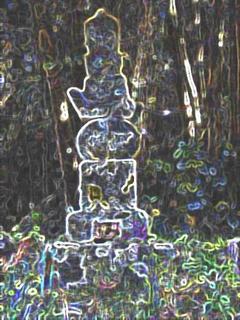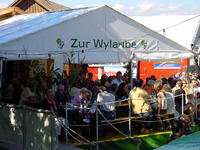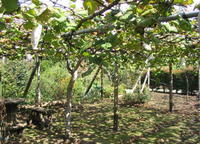:::::::::::::::::::::::::::::::::::::::::::::::::::::::::::::::::::::::::::::::::::::::::::::::::::::
HAWAII SAIJIKI
:::::::::::::::::::::::::::::::::::::::::::::::::::::::::::::::::::::::::::::::::::::::::::::::::::::
The Haiku Seasons of Hawaii
The seasons of Hawai'i are very much recognized and appreciated by Japanese-writing haiku poets in the islands.
I believe that the following book still provides some useful guidance:
ハワイ歳時記 (Romaji: Hawai Saijiki; English title: Hawaii Poem Calendar),
by 元山 三代松 (Motoyama Gyokushu), published by 博文堂 (Hakubundô),
Honolulu, and ゆく春発行所 (Yukuharu Hakkojo), Tokyo, 1970.
The book contains some 235 seasonal topics, as well as some "miscellaneous" or "seasonless" topics, many recognized by Japanese saijiki and many more specific to Hawai'i, many with English translations, and with plenty of haiku illustrating their use.
For Hawai'i, the author offers the following seasonal breakdown:
Spring: February-March-April (same as trad. Japanese spring)
Summer: May-June-July-August (extending one month beyond trad. J. summer)
Autumn: September-October-November (shifted one month later than trad. J. autumn)
Winter: December (only)
New Year: January (all month)
To me, this makes good sense, since the Islands in fact are only marginally tropical, lying across the tropic of Cancer, though the largest islands are a bit south of it.
In any case, there is nowhere on the planet that does not feel some seasonal effects (including most city-scapes and indoor spaces), so please don't be so hasty in dismissing the seasons.
Instead, look for the different quality and time periods of light at different times of the year, a different feel in the air, as well as those plants and animals whose phases and activities do indeed change from month to month. Even deep in the tropics of equatorial regions, some plants bloom
only at particular times of the year, and so on. (I have numerous books that document this fact.) This is not to mention the various holidays and annual events by which we mark the passage of our yearly round.
You will find many of these, and in particular the varying seasonal events of the sea, well documented in the Hawaii Poetry Calendar.
Bill Higginson
:::::::::::::::::::::::::::::::::::::::::::::::::::::::::::::::::::::::::::::::::::::::::::::::::::::
The Many Seasons In Hawaii
By Don Chapman
In fact, traditional Hawaiian culture counted 13 different seasons in the 12 months of the lunar year - based on air temperature, wind direction, which fish were biting and what plants were blooming or producing fruit.
“When the wiliwili blossoms,” says an old proverb, “the shark bites.”
We know in Hawaii that our seasons are driven by the surrounding ocean’s “thermal lag,” the couple of months between the shortest and longest days of the year and the coldest and warmest days of the year.
Read the full story here:
http://www.midweek.com/content/columns/editorsdesk_article/the_many_seasons_in_hawaii/
xxxxxxxxxxxxxxxxxxxxxxxxxxxxx

http://www.statefishart.com/states/west/hi.htm
oooooooooooooooooooooooooooooo
HAWAII FACTS & LINKS
Hawaii is made up of eight major islands that include: Hawaii, Oahu, Maui, Kawai, Kahoolawe, Molokai, Lanai and Niihau.
Hawaiian weather is quite consistent year-round. This is because of the warm sea surface temperatures that remain fairly consistent all year. Rather than four seasons in Hawaii, there are really only two - Summer and Winter.
Summer generally goes from May to October and is called Kau in Hawaiian.
Winter is known as Ho'oilo and generally runs from November to April.
................... The official Flowers of all 8 islands:
Hawaii - Red Lehua Ohia
Maui - Lokelani (Pink Cottage Rose)
Molokai - White Kukui Blossom
Kahoolawe - Hinahina (Beach Heliotrope)
Lanai - Kaunaoa (Yellow and Orange Air Plant)
Oahu - Ilima
Kauai - Mokihona (Green Berry)
Niihau - Pupu Shell
The State Bird:
The Nene, which is pronounced "nay-nay," is often referred to as the Hawaiian goose. Living in the rough lava has helped the Nene to change from web feet to a claw-like shape. Its wing structure has modified itself to accommodate shorter flights. Until the Nene was protected in 1949, it was nearly extinct through hunting and wild animals.
The unofficial state fish the Hawaiian Triggerfish. The actual name is very long! It is Humuhumunukunukuapua`a, which is pronounced humuhumunukunukuapua.
More facts are here:
http://www.usacitiesonline.com/hilinks.htm
http://gohawaii.com/weather/default.aspx
Hawaii, Triggerfish in the World Kigo Library
xxxxxxxxxxxxxxxxxxxxxxxxxxxxxxxxxxxxxxxxxxxxx
The University of Hawaii
:::::::::::::::::::::::::::::::::::::::::::::::::::::::::::::::::::::::::::::::::::::::::::::::::::::

wildfire
spread of weeds
in Pele's garden
Shanna Moore: Photo Album - Haiga from Hawaii
Shanna Baldwin Moore: Poettree - BLOG from Hawaii
Shanna Baldwin Moore: Photoshow HAWAII
:::::::::::::::::::::::::::::::::::::::::::::::::::::::::::::::::::::::::::::::::::::::::::::::::::::
...................... Hawaii Saijiki
under construction
Spring
Summer
Autumn
Bon Festival, O-Bon
Sulphur Butterfly
Winter
Surfing, Surfer, Surf
Windstorm
New Year
........................ Non-seasonal topics
Banyan Tree
Hawaiian Spirit
Hula Dance and the Goddess Laka
Lunchbox (bentoo)
Mango -
Vog (Volcanic Smog) (Hawaii, Big Island)
*****************************
Things found on the way

. Aloha Daruma
*****************************
Haiku
In Honolulu
nobody watches
"Hawaii Five-O".
John Tranter
Published in Sydney Morning Herald (Australia)
http://www.thylazine.org/peace/johntranter.html
xxxxxxxxxxxxxxxxxxxxxxxxxxxxx
ワイキキの海に浮かびて椰子並木
Waikiki no umi ni ukabite yashi namiki
Waikiki -
the palm tree on the roadside
reflected in the sea
hpmix
Japanese Haiku from Hawaii
(Tr. Gabi Greve)
:::::::::::::::::::::::::::::::::::::::::::::::::::::::::::::::::::::::::::::::::::::::::::::::::::::
[ . BACK to WORLDKIGO . TOP . ]
[ . BACK to DARUMA MUSEUM TOP . ]
:::::::::::::::::::::::::::::::::::::::::::::::::::::::::::::::::::::::::::::::::::::::::::::::::::::




































